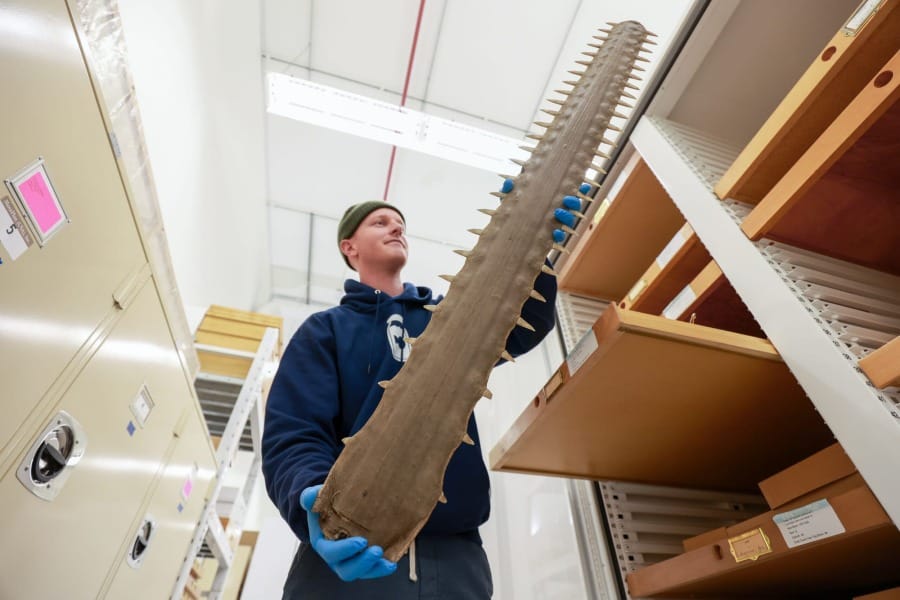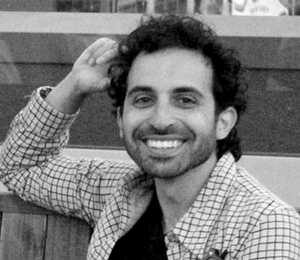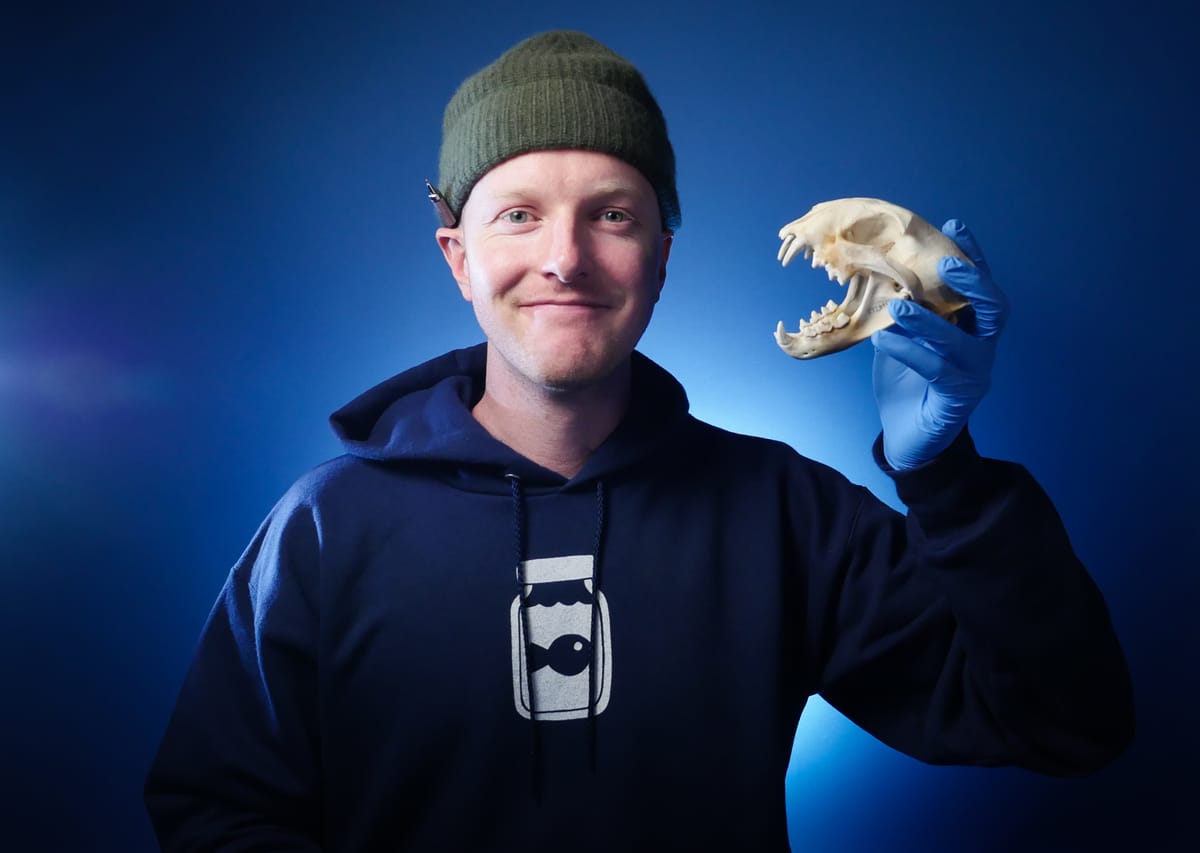What first drew me to Charlie Engelman's shortform nature videos was their simplicity. A gradient blue background frames the museum specimen of the moment, maybe a bright calcified starfish or a snail, held in place by blue gloved fingers. Engelman's Odd Animal Specimens series is calm, gentle, and unusually slow. Piano riffs bookend Engelman's questions and musings like "How do snails make more snails?"
The pacing and enunciation reminds me children’s TV. Still, anyone could learn something new from the videos he posts to millions of followers on Instagram, TikTok, and YouTube: starfish eyes are on their arms; crickets chirp with their wings; and "you don't need a male and female snail to make more snails, because most land snails are anatomically male and female."
Odd Animal Specimens is Engelman's project with University of Michigan, and began as research into the most effective ways to use museum specimens in film. To that, he has arrived at an answer. The goal is not to lecture, but rather to tell a simple story around one object that piques a newfound curiosity. “I've always thought that the goal of science communication isn't necessarily to teach you,” Engelman told me. “I'm trying to inspire people to care about this and become interested in it so that then on their own time, they'll pursue it more in a more involved way.”
Engelman’s videos are visually striking, but they’re unlike the hyperstimulating content that usually goes viral. That hasn't stopped Odd Animal Specimens from 1.8 million followers on Instagram and 3.6 million on TikTok. His video about carmine color — a natural red dye made from crushed up parasitic insects — currently has over 90 million views on Instagram alone.
Engelman’s success comes from his dual background in scientific practice and communication, given that he studied ecology as an undergrad and trained in online content creation. He approaches Odd Animal Specimens like any good science experiment. He tweaks tiny variables, asks for a lot of help, and follows his burgeoning intuition.
Sequencer spoke with Engelman about his approach to science communication — and why it’s working so well. The following is a lightly edited transcript of our conversation.

Sequencer: What’s the hardest part of the job for you?
Charlie Engelman: Finding which specimen to feature. I've spent the last three years being very, very particular about how I describe things and how I put together a video. And as time has passed, I've just accumulated more reasons why a video won't work. So anytime I pull out a specimen that I'm interested in filming, I'm immediately thinking of 50 reasons why the video probably won't do well.
You have such a distinct tone. How did you figure out what works for your audience?
By showing drafts to a lot of people. Early on, before posting anything online, I spent about four months making videos at different museums in Michigan and the Chicago Academy of Sciences, trying out different things and getting feedback. I learned that people like getting close-up views. People liked it when I spoke using what I call directive dialog: “look here,” or, “do you notice this?” People like it when I slowed down.
If you look at some of the early videos, they're significantly quicker. I've introduced piano tones to slow down the pacing, generate intrigue, and establish emphasis at certain points. This makes it very calm and gentle, which [reflects] some of the media that I've liked in my lifetime. A lot of other content that you might see online, though, is very fast, very loud, and very colorful. So Odd Animal Specimens goes against the grain of what’s popular, but in a way that's kind of a nice little hook when people come across it.
Now, I find that I need to show videos to people who are willing to tell you if something's bad. I have a handful of people, from friends and family to my wife, who have watched enough to recognize where I'm screwing up. My mom is really good at pacing and writing, and I have a friend who has a very good taste that's similar to the taste of the populace.
What’s an idea that failed?
Early in the project, I started with a darker and sinister tone because I thought it fit with the aesthetic of the specimens, like a walrus skull and a beaver skull. I pitched my voice down and was like, “Welcome to my cabinet of curiosities,” just pointing out similar things to what I would do now, like beavers have exceptionally long teeth with iron deposits on them.
It turned out to be too scary.
Ok. I need to see this.
Yeah … those are nuked. No one's seeing those! [Laughs] I didn't even post them.
How is your project continuing to evolve?
My videos seem like they're very simple. It's by design. As I make these videos, I can tweak very specific things then analyze the response. Do these specimens look better on blue or on white or on a green background? What color of gloves do I wear? How soon towards the beginning of the video do I insert a question? Do I have a slightly comedic tone? I can just change little things and it accumulates to a better and better product.

Where does your own taste differ from what your peers or audience seem to like?
When you know a lot about a subject, it’s hard to figure out if it would be interesting or not. Something new to me might also be new to someone else, but so niche that it's just uninteresting and it doesn't make sense. Whereas if I show someone a little thing that looks like a wasp and is actually a hoverfly, they're like, “No way! That looks like a wasp. Nobody knows that,” Then I'm like, okay, and then maybe that's a video idea.
Something I love in your videos is that you show science as a process of asking questions and even being wrong, like one video where you began with the assumption that a starfish’s mouth was in the same place as a sea urchin’s, then you gradually found where it actually was. What do you hope people take away from your videos?
Nobody's really pointed that out, but that's really nice to hear. Science and experts sometimes seem unrelatable in that they’re never wrong. So, posing “Why is something like this? I thought it was like that; let's figure out what it really is,” is how I hope to make science more approachable. It's okay to be wrong and it's okay to not know.
I'm not trying to teach people. I hope people take a closer look at the world, and look at the wonderful and interesting things that are right around them in their own world.
You mentioned that it’s hard to decide on the next specimen to film. What's on your wish list?
I want to film some narwhal teeth. And the Smithsonian has a giant squid eye that I want to film. Those are kind of niche. But interestingly, the stuff that is hard to film and hard to put online are birds. I would love to figure out ways to post bird specimens online without upsetting a lot of people. There seems to be a very vocal population of bird enthusiasts online that respond aggressively when you post any sort of bird specimen. That is kind of a puzzle that I have yet to solve.


